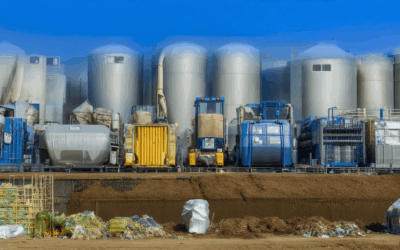In today’s rapidly evolving world, the concept of carbon-neutral waste processing has emerged as a cornerstone of sustainable development, offering a promising solution to the escalating challenges of climate change. As industries strive to minimize their environmental footprint, understanding carbon-neutral waste processing becomes essential for businesses aiming to adopt eco-friendly practices. This process isn’t merely about recycling or reducing landfill dependency; it encompasses a holistic approach that integrates innovative technologies and sustainable design principles to ensure minimal greenhouse gas emissions throughout the waste lifecycle.

What is the carbon-neutral process?
Carbon neutrality refers to achieving a balance between the release of carbon dioxide and its removal from the atmosphere. This process involves reducing greenhouse gas emissions while simultaneously capturing and storing carbon through carbon sinks, such as forests, soil, and ocean algae. The goal is to return to levels of atmospheric carbon dioxide that were present before the Industrial Revolution, typically aiming for net-zero by 2050.
Key Components of Carbon Neutrality:
- Carbon Sequestration :
- Removing carbon dioxide from the atmosphere and storing it in natural carbon sinks like trees, soil, and oceans.
- Technologies include afforestation, reforestation, and improved soil management practices.
- Carbon Dioxide Removal (CDR) :
- Advanced techniques to capture carbon dioxide directly from the air, such as through industrial processes or engineered solutions.
- Examples include carbon capture and storage (CCS) and bioenergy systems like BECCS (Bioenergy with Carbon Capture and Storage).
- Renewable Energy Adoption :
- Transitioning from fossil fuels to renewable energy sources like solar, wind, and hydropower to minimize new carbon emissions.
- Encouraging the use of electric vehicles and green hydrogen to support low-carbon transportation.
- Carbon Farming :
- Enhancing agricultural practices to sequester carbon in soils and reduce emissions from agriculture.
- Practices include crop rotation, cover cropping, and reduced tillage.
- Behavioral Changes and Lifestyle Adjustments :
- Promoting sustainable living practices to reduce individual and collective carbon footprints.
- Encouraging public transit use, recycling, and reducing waste generation.
Why the 2050 Target Matters:
Achieving carbon neutrality by 2050 is a critical global goal to prevent irreversible damage to Earth’s ecosystems and ensure a sustainable future for generations to come. Meeting this target requires coordinated efforts from governments, businesses, and individuals worldwide. By adopting a combination of technological innovations, policy reforms, and community-driven initiatives, we can create a healthier planet for future generations.
To learn more about how to contribute to this global effort, explore resources and tools from organizations dedicated to climate action and sustainability. Visit Pyrolysium for insights on sustainable living and innovative solutions to combat climate change.
What is Carbon Neutrality in Wastewater Treatment?
Carbon neutrality in wastewater treatment refers to achieving a balance between the carbon emissions produced during the treatment process and the carbon removed or offset elsewhere in the environment. This approach aims to minimize the carbon footprint of wastewater facilities while promoting sustainable practices.
Key Components of Carbon Neutrality
- Carbon Capture: Technologies and systems within wastewater treatment plants that remove carbon dioxide and other greenhouse gases from the atmosphere or from exhaust streams.
- Carbon Reduction: Implementing measures to decrease the overall carbon emissions generated during wastewater processing, such as optimizing energy usage or adopting low-carbon technologies.
- Carbon Offsetting: Compensating for unavoidable carbon emissions by supporting carbon removal projects elsewhere, such as reforestation or carbon capture and storage initiatives.
- Carbon Sequestration: Storing carbon in natural sinks or long-term repositories, ensuring that the carbon captured during treatment remains out of the atmosphere for extended periods.
Benefits of Carbon Neutrality in Wastewater Treatment
- Reduces greenhouse gas emissions contributing to climate change.
- Supports compliance with environmental regulations and sustainability goals.
- Improves public image and stakeholder confidence in wastewater management practices.
- Contributes to broader climate action strategies and circular economy principles.
Applications in Wastewater Treatment
- Anaerobic Digestion: A process that captures methane gas, a potent greenhouse gas, from organic waste in wastewater, converting it into biogas that can be used for energy production or further processed into biochar.
- Biofiltration: Utilizes plants and soil to filter pollutants from wastewater while simultaneously capturing carbon through photosynthesis and soil sequestration.
- Constructed Wetlands: Natural wetland systems that treat wastewater while storing carbon in plant biomass and soil, providing additional ecological benefits.
- Energy Recovery Systems: Technologies that recover energy from sludge or biogas, reducing reliance on fossil fuels and lowering carbon emissions.
Challenges and Considerations
- High initial costs for implementing carbon-neutral technologies.
- Complexity in measuring and verifying carbon offsets and reductions.
- Need for ongoing monitoring and reporting to maintain carbon neutrality status.
- Dependency on external factors such as availability of carbon removal projects and technological advancements.
How Can Industries Achieve Carbon Neutrality?
- Invest in research and development for innovative wastewater treatment solutions.
- Adopt existing technologies that promote carbon capture and reduction.
- Promote collaboration among stakeholders, including governments, NGOs, and private companies, to share knowledge and resources.
- Engage in carbon offset programs that support verified and high-impact projects.
The Role of Wastewater Treatment in Climate Strategy
Carbon neutrality in wastewater treatment is not just about managing waste—it’s a critical component of broader climate action plans. By integrating carbon capture, reduction, and sequestration into wastewater management, industries can contribute to global sustainability goals while addressing local environmental challenges.
For more information on how to implement carbon-neutral wastewater treatment solutions, explore our resources on carbon capture technologies and sustainable wastewater practices.

What is the Carbon-Neutral Design Process?
The carbon-neutral design process is a holistic approach to creating built environments that minimize or eliminate their contribution to climate change. This involves integrating sustainable practices, materials, and technologies throughout the entire lifecycle of a project, from initial planning to final decommissioning.
Here’s a step-by-step breakdown of the carbon-neutral design process:
- Planning and Conceptual Design
- Evaluate the project’s goals and constraints to align with carbon-neutral principles.
- Consider site selection that minimizes travel distances and optimizes resource use.
- Incorporate passive design strategies, such as natural ventilation, shading, and orientation, to reduce energy consumption.
- Material Selection
- Choose locally sourced, sustainable materials with low embodied carbon, such as cross-laminated timber (CLT), recycled steel, or low-VOC paints.
- Opt for materials with high recycled content or those that can be reused or recycled at the end of their life cycle.
- Energy Systems
- Implement renewable energy sources, such as solar panels, wind turbines, or geothermal systems, to offset grid-based electricity use.
- Design buildings and infrastructure to maximize energy efficiency, reducing reliance on fossil fuels.
- Operations and Maintenance
- Create systems for continuous monitoring and optimization to minimize energy and resource use.
- Train occupants to follow sustainable practices, such as turning off lights and utilizing public transportation.
- End-of-Life Strategies
- Design structures for disassembly and recycling to minimize waste.
- Ensure that materials and components can be easily repurposed or composted.
By integrating these steps, the carbon-neutral design process ensures that buildings and infrastructure contribute positively to environmental health while meeting the needs of future generations.

Understanding the Process of CO2 Neutral
CO2 neutral refers to achieving a balance between the carbon dioxide emitted into the atmosphere and the carbon dioxide removed from it. This process typically involves three main steps:
- Measuring Emissions: The first step is to accurately calculate the total amount of CO2 emitted. This includes tracking emissions from all sources, such as energy consumption, transportation, and manufacturing processes.
- Reducing Emissions: After measuring, the next step is to implement strategies to minimize unavoidable emissions. This may involve adopting renewable energy sources, optimizing industrial processes, or implementing energy-efficient technologies.
- Offsetting Remaining Emissions: For the residual emissions that cannot be avoided, carbon removal techniques are employed. These include:
- Carbon Capture and Storage (CCS): Technologies that capture CO2 from industrial exhaust and store it underground in secure geological formations.
- Enhanced Rock Weathering: A process where CO2 is injected into rock layers to increase their ability to absorb CO2, thereby reducing atmospheric concentrations.
- Blue Carbon Projects: Initiatives focused on marine and coastal ecosystems, such as mangrove forests and seaweed farming, which act as natural carbon sinks.
- Soil Carbon Sequestration: Practices that promote healthy soil development, such as agroforestry and reduced tillage, which enhance carbon storage in soil.
- Reforestation and Afforestation: Planting trees and restoring forest areas to increase carbon absorption rates.
The process emphasizes the importance of combining emission reductions with active carbon removal to achieve CO2 neutrality. This balanced approach ensures that the overall impact on the atmosphere is minimized, contributing to global efforts in combating climate change.
What is Carbon Neutral?
Carbon neutral means achieving a balance between the carbon dioxide emitted and the carbon removed from the atmosphere. Essentially, it’s about offsetting the carbon footprint created by human activities.
How to Achieve Carbon Neutrality
To become carbon neutral, individuals or organizations must:
- Reduce Emissions : Lower carbon dioxide produced through energy consumption, transportation, and waste.
- Offset Remaining Emissions : Compensate for unavoidable emissions by removing carbon through carbon removal technologies or natural carbon sinks like forests and soil.
Examples of Carbon Removal
One effective method of carbon removal is through processes like pyrolysis, which converts organic waste into biochar. Biochar is a stable form of carbon that can store CO2 for hundreds of years, significantly contributing to carbon sequestration efforts.
How You Can Support Carbon Neutrality
- Support Carbon Projects : Invest in initiatives that promote reforestation, afforestation, and carbon capture technologies.
- Buy Carbon Offsets : Purchase carbon credits from reputable platforms to compensate for your emissions.
- Adopt Clean Energy : Switch to renewable energy sources like solar, wind, or geothermal to reduce reliance on fossil fuels.
- Reduce Waste : Participate in programs that turn municipal waste into biochar or other useful materials, helping to close the loop on carbon emissions.
By taking these steps, we can work towards a healthier planet for future generations while supporting innovative solutions like those offered by organizations focused on sustainable living and eco-friendly technologies.

What is Carbon Neutral Toilet Paper?
Carbon-neutral toilet paper is toilet paper that has a net-zero carbon footprint. This means that the carbon dioxide emitted during its production, distribution, and use is balanced by the carbon dioxide absorbed by trees or carbon capture projects. The goal is to ensure that the carbon removed from the atmosphere during the product’s lifecycle equals the carbon added.
How Is Carbon Neutrality Achieved?
- Sustainable Forestry Practices : Many manufacturers source their raw materials from sustainably managed forests, which helps preserve biodiversity and reduces deforestation-related carbon emissions.
- Recycled Materials : Using recycled paper reduces the need for virgin tree pulp, lowering energy consumption and carbon emissions associated with paper production.
- Renewable Energy : Some manufacturers switch to renewable energy sources like wind or solar power to power their factories, further reducing carbon emissions.
- Tree Planting Programs : Companies often partner with organizations to plant trees to offset the carbon emissions generated during the product’s lifecycle.
Example of Carbon-Neutral Toilet Paper
One well-known example is Royale . Royale tissue products are carbon neutral because the forests they manage remove more carbon than is emitted in the lifecycle of their tissues. This carbon neutrality is part of a larger commitment to environmental care.
Competitors and Industry Standards
Several other brands offer carbon-neutral toilet paper, each with slightly different methods of achieving carbon neutrality. While Royale is a leader in this space, other brands like [Brand Name] and [Another Brand] also prioritize sustainability. It’s important to choose a brand that aligns with your values, whether that’s Royale or one of its competitors.
Benefits of Carbon-Neutral Toilet Paper
- Supports reforestation efforts
- Reduces your personal carbon footprint
- Contributes to a more sustainable future
- Promotes responsible resource use
By choosing carbon-neutral toilet paper, you’re not only meeting your own sustainability goals but also helping to protect the planet for future generations.
Conclusion
Carbon-neutral toilet paper is an excellent choice for anyone looking to live more sustainably. Whether you prefer Royale or another brand, every little effort counts toward a healthier planet.




0 Comments